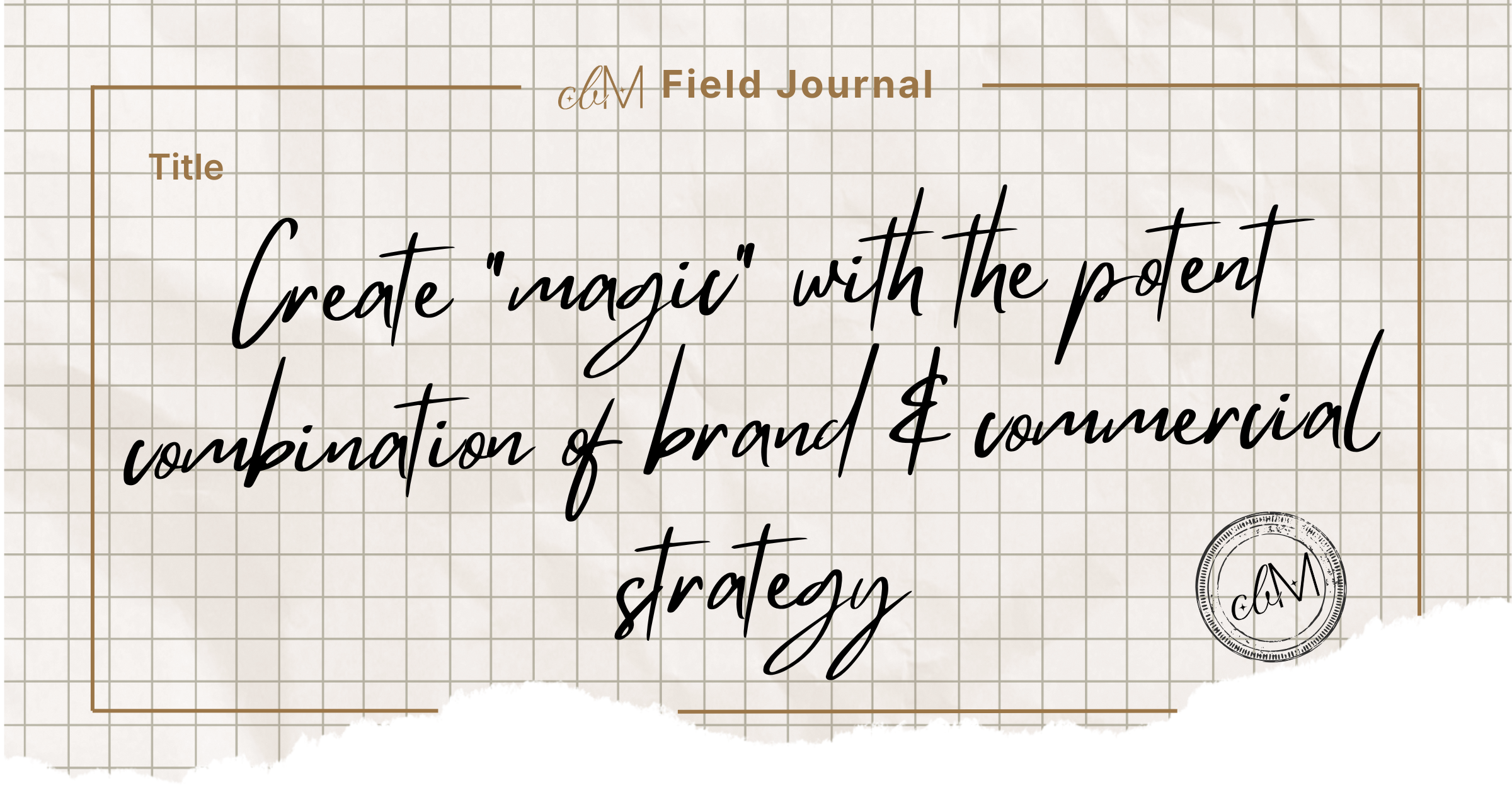
24 Nov Create “Magic” with the Potent Combination of Brand and Commercial Strategy
Struggling to stand out in a competitive market while driving meaningful revenue growth? You are not alone. The disconnect between brand identity and commercial execution is one of the most common blindsides preventing science and technology companies from scaling with speed and credibility.
The lack of a unified approach to branding and commercial strategy exacerbates these struggles. For example, a strong brand can address pricing objections by emphasizing value, while an informed commercial strategy ensures the brand aligns with market needs. Alternatively, combining these two critical elements can have a “magical” impact on businesses. This is why adopting a systematic and parallel approach to brand creation and commercial planning is critical for overcoming these hurdles.

This blog kicks off a new series where we’ll delve into each step of the brand and commercial strategy creation process, exploring how a systematic and parallel approach can streamline complex workflows and deliver exceptional results. From laying the groundwork in research to strategically executing a compelling narrative, we believe in a structured yet flexible process tailored to each organization’s goals and market.
But first, we must get on the same page with some important definitions.
Defining Brand Strategy
At its core, brand strategy is a framework to establish the brand and help it stand out among competitors. It encompasses the values, personality, and story of your brand, shaping every interaction you have with customers and stakeholders. Brand strategy defines your value proposition, target personas, messaging, and visual identity. It’s not just about logo and design; it’s about creating a cohesive narrative that resonates with your audience and fosters trust and loyalty. By crafting a brand strategy that speaks directly to the needs and values of your audience, you establish a recognizable presence in the market that differentiates you from competitors and builds a foundation for long-term connection.
Organizations struggle with branding, making it challenging on a number of levels.
- Differentiating in a Crowded Market: Standing out often requires a unique value proposition and a cohesive narrative – something that’s frequently overlooked or underdeveloped.
- Connecting with the Audience Emotionally: Companies often focus heavily on technical features and benefits, neglecting the emotional aspect of decision-making. Building a relatable and compelling brand that resonates with both logical and emotional drivers is a common struggle.
- Lack of Internal Alignment: Brand creation can falter if key stakeholders within an organization aren’t aligned on the brand’s mission, vision, and values. This misalignment often leads to inconsistent messaging and brand confusion.
- Scaling the Brand Globally: Expanding into new markets requires adapting the brand to resonate with diverse audiences while maintaining core identity. Striking this balance is a significant challenge.
Defining Commercial Strategy
On the other hand, commercial strategy is the comprehensive plan to achieve business goals and gain a competitive advantage in the marketplace. It addresses the “what” and “where” in terms of product positioning, pricing, customer segmentation, and go-to-market plans. A strong commercial strategy aligns business operations with market demands, optimizing the steps needed to convert awareness into revenue. It’s designed to ensure that every commercial decision – from product development to distribution – is strategically aligned with business goals and maximizes return on investment.
This sounds great, but companies frequently struggle with organizing and implementing their commercial plans.
- Misaligned Go-To-Market Strategy: Without a clear understanding of the target audience and market needs, B2B businesses often waste resources on misaligned sales and marketing efforts, resulting in missed opportunities and growth.
- Inefficient Lead-to-Revenue Funnel: Converting leads into paying customers is more complex in B2B sales due to longer sales cycles, multiple decision-makers, and complex buyer journeys. Many businesses struggle with defining and streamlining this process.
- Pricing and Value Communication: Defining the right pricing strategy for innovative products or services can be challenging. Companies often struggle to balance competitive pricing with communicating the value and ROI of their offerings.
- Failure to Capitalize on Market Gaps: Without thorough market research and gap analysis, businesses risk focusing on oversaturated areas or developing products/services that don’t fully address market needs.
The Systematic Approach: Laying the Foundation
Successful brand and commercial strategies start with a systematic approach in three clear phases:
- Research & Analysis: Every effective strategy is rooted in a deep understanding of the market and customer needs. This phase involves rigorous research, gathering insights that guide every subsequent decision.
- Strategy Development: The next phase focuses on developing a strategic blueprint that aligns brand messaging and commercial goals with the company’s vision and market position.
- Implementation: Finally, the strategy comes to life through a targeted implementation plan that includes every touchpoint your audience will interact with, from the website to sales collateral.
Each of these phases is designed to streamline complexity and ensure that all elements of the brand and commercial strategy work together seamlessly, creating a lasting impact.
Parallel Processes: Unique Tracks for Brand and Commercial Strategy
To maximize impact, we develop brand and commercial strategies as parallel processes that align at each phase yet differ in focus and execution.
The research & analysis phase for brand strategy involves defining a value proposition, mapping personas, and conducting competitive analysis. Meanwhile, commercial strategy focuses on understanding the market landscape with customer segmentation, market gap analysis, and financial analysis. Together, these efforts create a comprehensive picture of opportunities and challenges.
During the strategy development phase the brand strategy takes shape through messaging, positioning, and visual identity, establishing a cohesive brand presence. Concurrently, the commercial strategy centers around go-to-market plans, product architecture, and pricing models that support revenue goals.
Finally, each strategy is implemented with distinct but interconnected assets. Brand strategy elements, such as website design and content, work in tandem with commercial strategy elements like sales collateral and pitch decks, ensuring both brand governance and sales effectiveness.
Why You Need a Thought Partner
Navigating the intricate relationship between brand and commercial strategy is no small feat. The process outlined in this blog is ideal for new companies and simple products, but the reality is that businesses are hardly ever this straightforward. Finding a partner who can meet your business where it is at and still achieve these results can be a gamechanger.
With Creative Bio Marketing, you gain a strategic partner dedicated to helping you create the “magic” that happens when brand and commercial strategy work in harmony. Our systematic and parallel process not only saves time but also positions your brand for meaningful growth and recognition. Together, we’ll craft a strategy that’s as unique as your organization, driving results that resonate today and build the credibility for sustained success in the future.

